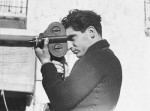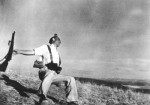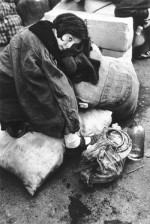Column Name
Title
In writing this review and exploring the role of photojournalism in history, I became acutely conscious of the skill and art of the photographers whose work appears in the daily newspapers and magazines I read. Most of us take these photos for granted. We know, of course, that individual photographers are responsible for this work, but only when something dramatic happens—a photographer is killed in the line of fire while reporting a war, for example—do we tend to take notice.
Robert Capa holding an Eyemo movie camera at the Segovia front, Spain, May 1937, gelatin silver print; (© International Center of Photography)
(Photo by Gerda Taro)Death of a Loyalist militiaman, Cerro Muriano, Córdoba front, September 5, 1936, gelatin silver print (© Cornell Capa International Center of Photography)
(Photo by Robert Capa)Body
Tragically, both of the photojournalists featured in the I.C.P. exhibition died while pursuing their photography. Robert Capa, the more famous of the two, was killed in 1954 at the age of 41, when he stepped on an anti-personnel mine in Indochina. Capa’s companion, Gerda Taro, the first woman known to have photographed during a battle, was also the first woman killed in action, shot down in Spain at the age of only 26.
The exhibition and its accompanying catalogue tell the history of the picture press, and meticulously show the working methods of two of its most important practitioners.
Divided into four smaller exhibitions, the theme of the whole is visual images in times of war—the making of them, their printing and distribution, and their often horrific beauty. The first exhibition, “This Is War! Robert Capa at Work,” features six of Capa’s most important war stories, and includes numbers of photos and documents never exhibited before. The second, “Gerda Taro,” includes over 80 photographs Taro made during her all-too-brief life (she lived from 1910-1937).
The third show, “Other Weapons: Photography and Print Culture during the Spanish Civil War,” places emphasis on the reproduction and circulation of images in magazines, bulletins, weeklies, and newspapers during the nearly four years of the Spanish Civil War. It emphasizes the importance of “print culture” in terms of news and propaganda. The fourth exhibition is an installation by a contemporary Barcelona-based artist, Francesc Torres. Titled “Dark is the Room Where We Sleep, it focuses on one unmarked mass grave in the village of Villamayor de los Montes, in northern Spain. There, on the night of September 14, 1936, 46 civilians sympathetic to the Republican government were slaughtered by insurgents loyal to the fascist leader, General Francisco Franco. This grave, only one of an estimated 30,000 such sites, demonstrates a collective reluctance to acknowledge the brutality during the civil war. In many ways, Torres’s installation can be seen as parallel to Picasso’s great anti-war masterpiece, Guernica (1936), which was also painted in response to the horrors of the Spanish Civil War but has come to stand as a protest against human violence during wartime throughout history.
Capa, one of the leading photographers of the 20th century, captured images from a number of wars, including the Spanish Civil War, the Sino-Japanese conflict in 1938 (he spent seven months in China), and the Second World War. His photos of the Omaha Beach landing in Normandy, France, on D-Day in June 1944 have almost become synonymous with the Allied victory in World War II. Probably his most famous photo, the iconic image popularly known as “Falling Soldier,” documents the death of a loyalist soldier in Spain in 1936. This photo has been the subject of extensive controversy, raising many questions aboutCapa’s working methods and the methods of war photographers in general. It has been suggested that the photo did not really portray a soldier who had just been shot and was dying, but that it was staged to look that way. There is no question that some of Capa’s photos were staged, but recent research indicates that the most likely explanation for this picture is that the soldier (who has been definitively identified, and documented to have died on September 5, 1936) was actually posing for a heroic portrait when the enemy opened fire and shot him down. Whatever the truth, the photo has remained to us a symbol of Republican Spain, much as Goya’s famous Third of May, 1808 embodies the resistance, heroism, and brutality of 19-century Spain. Both are transcendent, symbols of “man’s inhumanity to man.”
Capa’s war photographs are the most dramatic, but his other photos of illustrious friends such as Ingrid Bergman, Ernest Hemingway, John Steinbeck, and Pablo Picasso also stand as a testament to the man’s photographic artistry.
The accompanying show of the work of Gerda Taro is the first major exhibition of her work. It not only documents the Spanish Civil War (which she photographed side-by-side with Capa), but also shows the changing roles of women in Europe during the 1930s. Taro photographed female militia members in Barcelona and Valencia. Although her career was tragically cut short, she did produce a large body of formally innovative work, much of which has never been on public view before.
There has perhaps never been a more opportune time to mount such an ambitious exhibition. The International Center of Photography has a beautiful and convenient midtown space in which to view and study these images, documents, and working methods of great photojournalists. During the lifetimes of Capa and Taro, shows like this would never have taken place. The photos were made for mass distribution in the press. This does not, however, mean that we cannot learn from and appreciate these powerful images. As Willis E. Hartshorn, I.C.P.’s Ehrenkranz Director, has stated: “At a moment of conflict across the globe, and a decidedly new era in the making and distribution of war images through digital technology, it seems timely to examine the legacy of the photographer who defined the medium with his Leica.”
Unfortunately, as National Public Radio reported recently, photojournalists are being increasingly targeted in Iraq. Portrayal of unvarnished truth poses great threats for those responsible for brutality.
These exhibitions provide us with an opportunity to examine some of the iconic images of the 20th century, and also set benchmarks for present-day photojournalism. The shows are powerful, revelatory, and beautiful. The International Center of Photography is located at 1114 Avenue of the Americas, at 43rd Street. The exhibitions run through January 6.







